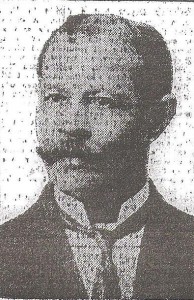In the years immediately following the end of the Civil War, there was no greater desire among the millions of newly freed and newly enfranchised African Americans than to obtain education. The American Missionary Association (A.M.A.), an abolitionist group founded in 1846, immediately recognized the great missionary which existed in the Southland, where the lessons of the Bible and the primer were sought above all else. In 1869, the A.M.A. established Straight University in New Orleans, an institution which offered elementary, preparatory high school, and university-level courses. The university was named for Seymour Straight, a philanthropic cheese manufacturer from Ohio. While supported by the mostly-Congregational A.M.A., Straight University was a nondenominational but distinctly Christian institution. Straight included graduate schools of law, medicine, theology, and a normal school for teachers.
In 1874, a Law Department was added to the university. The Law Department was a draw for young men, both white and colored, who upon graduation were admitted to practice before the State Supreme Court. The first class of graduates from the Law Department completed their studies in 1876. Without a true law library at their disposal, the students read the major treatises in the offices of their professors. The distinguished faculty included Melvin M. Cohen, who wrote a 500-page treatise on admiralty law, and John S. Whitaker and William R. Whitaker, uncle and nephew, who were both major figures at the bar and in civic life. It was the untimely deaths of several faculty members, which led to the closure of the law school in 1886, after twelve years of existence.
An interesting fact, is that in its twelve-year history, at least one-third of the graduates of the Straight University Law Department were white. The scarcity of law programs in the city and the region, meant that this school established primarily for the children of slaves, included several dozen white young men among its graduates.
Among the seventy-four graduates of Straight’s Law Department, are several notable figures. The Citizens’ Committee, organized in 1891 to challenge the state’s Jim Crow car act, included among its members Louis-André Martinet, Rodolphe-Lucien Desdunes, and Eugene Luscy. Martinet, who published the militant Daily Crusader from 1890 to 1896, was also a graduate of Straight University’s Medical Department and practiced both law and medicine. Desdunes is best known for his opus magnum, Nos Hommes et Notre Histoire (1911), a history of the colored Creole community in New Orleans. Another distinguished graduate, Thomas de Saliere Tucker, served for fourteen years as the founding president of what is now Florida Agricultural and Mechanical University (FAMU). One of the members of the last class, René Calvin Metoyer, practiced in New Orleans for over forty years and in 1917, became only the second black attorney to be commissioned a notary public.
* All of the graduates are from New Orleans, unless otherwise noted.
1876
Alfred E. Billings
John W. Cumberland
Robert H. Isabelle
Eugene Luscy
Louis A. Martinet, M. D.
Alexander F. Riard
Samuel J. N. Smith
John E. Staes
1878
Bertrand Courrege
Thomas Flanagan
Hamilton N. Gautier – Gretna, Louisiana
Edward Hunt
Oliver L. Garrett – Canton, Mississippi
Robert L. Thompson – [Bayou?] Teche, Louisiana
1879
Charles A. Baquie – Hahnville, Louisiana
John G. McLeod
B. Montz – Morgan City, Louisiana
Vincent Mielly
Edward M. Purcell
Malone Wheless – Washington, D. C.
1880
Peter E. Burke
Charles H. Breen
George P. Davis
George G. McLean
John G. McMahon
Lawrence O’Donnell
Joseph S. Schwab
John Fouga – Arizona
1881
S. P. Bouchereau
Thomas S. Collins
H. R. Grandmount
Charles W. Hunter
Patrice Leonard – Plaquemines Parish, Louisiana
Owen Riedy
William H. Seymour
1882
Lucien Adams
Joseph William Carew
Thomas de Saliere Tucker – Pensacola, Florida
Benjamin Armsbruster
Rudolph Lucien Desdunes
Henry Heidenhain
Frank George Ulrich
Timothy James Gilloly
Oregon W. Long
1883
William Golding
Paul Reusch
George W. Deering, Jr.
William H. Hodgkins – Nashville, Tennessee
Henry N. Frisbie
Charles A. Bourgeois – St. Charles, Louisiana
Matthew A. Grace
David C. Moise
J. Parish Childress
1884
Charles B. Perry – Oxford, Connecticut
Felix Berhel
William H. Yates
J. J. O’Sullivan –
Sanford B. Horton – St. Joseph, Missouri
James J. Kearns
Ernest Longpre
1885
Edmond H. Chadwick
John L. Davies
David B. Temple – Vicksburg, Mississippi
John F. Patty – Franklin, Louisiana
Michael J. Griffin
Charles A. Roxborough – Iberville Parish, Louisiana
Claudius B. Suares
Oscar Pillman – Algiers, Louisiana
1886
Paul LaSalle
Thomas F. Maher
Rene C. Metoyer
John D. Grace
Andre Doriocourt
George Baldey
Jari C. Honora




Till current times there is a Louis A Martinet Legal Society in many communities in So Louisiana. The Society is preponderantly made up of African American lawyers and judges. As stated in the Greater New Orleans Chapter History, The society was formed not only to provide professional support but to combat Jim Crow not just on the streets but in the courtroom as well.
Powerful story so relevant even today. Thank you
Do you have info on Straight University Medical School from 1890 to 1900?